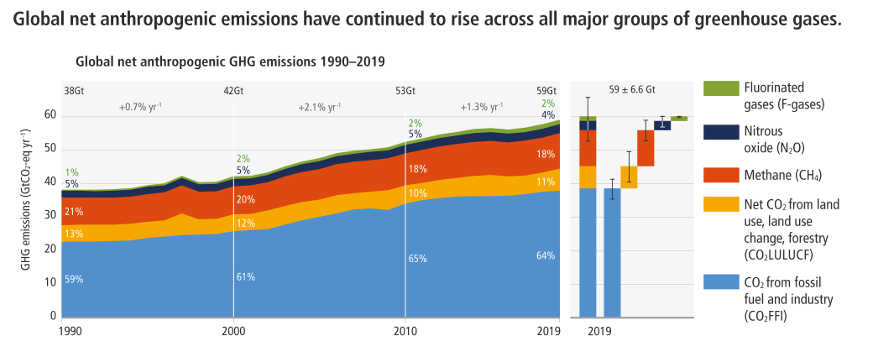IPCC 6th Assessment Report.
~Preet.

The Intergovernmental Panel on Climate Change (IPCC), the United Nations' climate scientific authority, has issued the third part of its Sixth Assessment Report (AR6). The second half of the study, which included climate change consequences, risks and vulnerabilities, and adaptation strategies, was released in March 2022. The first section of this study, which covered the physical science of climate change, was released in 2021. It has previously cautioned that 1.5 degrees Celsius of warming was likely to be attained by 2040.
Global net anthropogenic greenhouse gas (GHG) emissions were 59 gigatonnes of carbon dioxide equivalent (GtCO2e) in 2019, up 54% from 1990. The term "net emissions" refers to emissions that are accounted for after subtracting emissions absorbed by the world's forests and seas. Anthropogenic emissions are those that result from human-caused activities such as coal combustion for energy or forest harvesting. This increase in emissions has been primarily driven by CO2 emissions from the combustion of fossil fuels and the industrial sector, as well as methane emissions. However, the average annual rate of growth dropped to 1.3 percent per year from 2010 to 2019, compared to 2.1 percent per year from 2000 to 2009. At least 18 nations have continuously lowered GHG emissions for more than ten years owing to decarbonization of their energy systems, energy efficiency initiatives, and reduced energy consumption.
Carbon disparity persists, with Least Developed Countries (LDCs) releasing just 3.3 percent of global emissions in 2019. Their average per capita emissions from 1990 to 2019 were under 1.7 tonnes CO2e, compared to the world average of 6.9 tCO2e. LDCs produced less than 0.4 percent of total historical CO2 emissions from fossil fuels and industry from 1850 to 2019. In 2019, 41 percent of the world's population resided in countries emitting less than 3 tCO2e per capita.
Adding together the NDCs stated by nations through October 2021, the IPCC concludes that warming is likely to surpass 1.5 degrees Celsius (°C) this century, violating the Paris Agreement's objective. Nationally Determined Contributions are current promises made by nations that have signed the Paris Agreement (NDCs). CO2 emissions from current and planned fossil fuel infrastructure — coal, oil, and gas — play a significant role in this expected failure. The IPCC describes what the world has to do in its best-case scenario, known as the C1 pathway, to restrict temperatures to 1.5°C with little or no 'overshoot.' Overshoot refers to global temperatures momentarily exceeding the 1.5°C barrier before being brought back down by technology that remove CO2 from the atmosphere. To accomplish the C1 route, global GHG emissions must be reduced by 43% by 2030.
To meet the 1.5°C objective, widespread'system reforms' across the energy, buildings, transportation, land, and other sectors are necessary, which will entail adopting low-emission or zero-carbon growth paths in each sector. And solutions are accessible at reasonable prices. Since 2010, the costs of low-emission technology have steadily decreased. On a unit cost basis, solar energy has plummeted by 85%, wind energy by 55%, and lithium-ion batteries by 85%. Their deployment, or use, has risen several times since 2010 — ten times for solar and one hundred times for electric cars. Among the numerous alternatives are the reduction of fossil fuel consumption in the energy sector, demand management and energy efficiency in the industrial sector, and the adoption of'sufficiency' and efficiency principles in building construction.
It also states that demand-side mitigation, such as adopting plant-based diets or switching to walking and cycling, "may cut global GHG emissions in end-use sectors by 40-70 percent by 2050 compared to baseline scenarios" and boost wellbeing. The majority of the potential for demand-side mitigation is now concentrated in industrialised nations.
According to the IPCC, low-cost climate mitigation solutions might cut world GHG emissions in half by 2030. Indeed, the long-term advantages of reducing global warming outweigh the costs. Investing in decarbonization would have a negligible influence on world GDP (GDP).
However, financial flows fall short of the amounts required to meet the aggressive mitigation targets. The agricultural, forestry, and other land uses (AFOLU) sector and underdeveloped nations have the biggest discrepancies. However, the global financial system is broad enough, and there is "enough global capital and liquidity" to address these disparities. It recommends increased public grants for developing countries, as well as "increased levels of public finance and publicly mobilised private finance flows from developed to developing countries in the context of the USD 100 billion-a-year goal; increased use of public guarantees to reduce risks and leverage private flows at lower cost; local capital market development, and greater trust in international cooperation processes."
Comments
Post a Comment